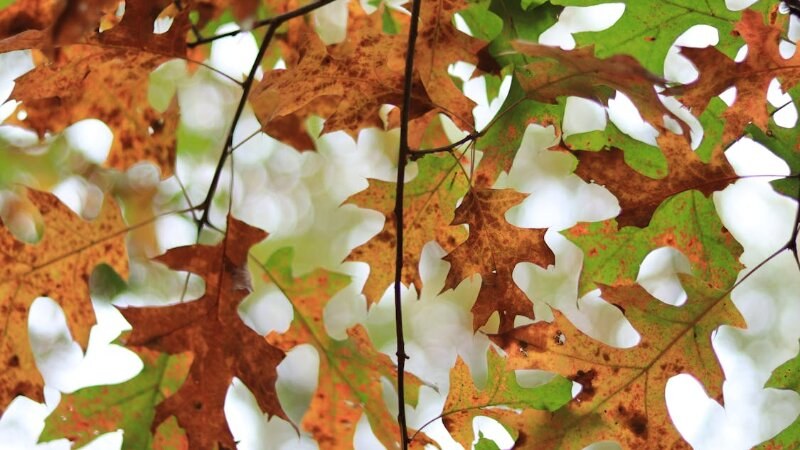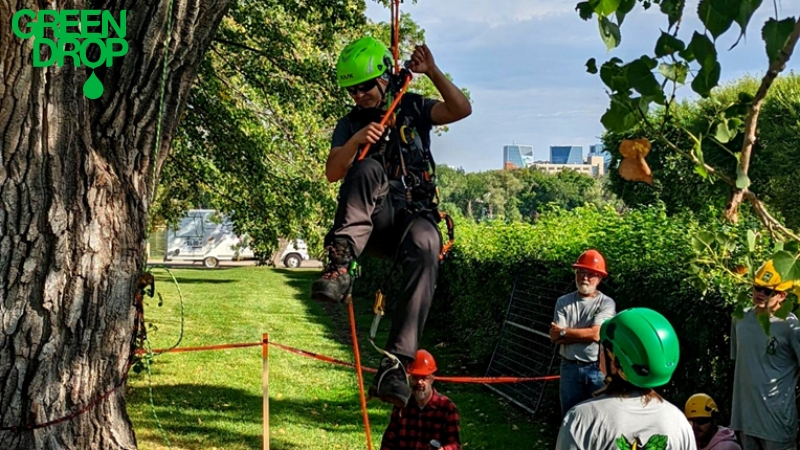Oak Wilt: Everything You Need to Know About This Tree Disease
Reading time: 7 minutesWestern Canada’s beautiful oak trees are loved almost as much as its iconic red maples (and their tasty maple syrup!). Unfortunately, they’re also susceptible to some pretty nasty tree diseases that primarily only affect oaks.
In this blog, we put the spotlight squarely on oak wilt (not to be confused with oak decline). Here’s what to know and how we can help you preserve your tree health for years to come.

What Is Oak Wilt?
Like many diseases that can damage or kill a tree, oak wilt is caused by a fungus. As it spreads throughout the tree's vascular system, it inhibits the absorption of nutrients, oxygen, and water.
Although this condition has affected oak trees in America since the start of the 1900s, the first case of oak wilt ever recorded in Canada was actually only in 2023, according to the Invasive Species Centre.
Oak wilt is an incredibly aggressive tree disease, often causing death within just a few weeks after infection. Once a tree has oak wilt, it must be removed to destroy mycelium networks and eliminate the possibility of spore mat formation.
Oak wilt also spreads through root grafts, which can be especially problematic for nearby trees. This allows the disease to multiply without the need for vectors, potentially resulting in the infection of any trees within close proximity, even after a tree has been reduced to its stump.
Does Your Tree Have Oak Wilt?
According to the Canadian Food Inspection Agency, you may be dealing with a case of oak wilt if:
- You see premature wilting of oak leaves that starts from the outside of the leaves and works its way inward
- Leaves are yellowed, dull green, or browning
- You see dark rings in the cross-sections of infected branches
- There are deep cracks in the bark of oak trees near the trunk
- You see grey, black, or white coloured fungus underneath a dead tree's bark if you peel it away
- There's a premature leaf drop that happens before fall and starts at the tree's crown
It’s important to keep in mind that many other tree diseases cause similar symptoms. For example, anthracnose also produces browning and early leaf drop but may be treatable with a copper-based fungicide.
Having your tree tested can help you determine which pathogens are affecting your tree so you can respond appropriately. When you test, you’ll know exactly what’s wrong and what to do next.
How Does Oak Wilt Spread?
So, Oak wilt mainly hits oak trees during the spring. The fungus spreads everywhere in red oaks as the tree dies, but in white oaks, it sticks to just the new year's growth.
When red oaks die, they grow mats on their bark that attract sap beetles. These beetles carry the fungus to healthy trees through wounds.
The fungus can spread in two ways: above ground and below ground.
Above ground
Here, Nitidulid beetles or bark beetles transport the spores to the wounds on new trees.
Below ground
It travels through connected roots of the same tree species. This fungus stays on dead trees for about a year above ground but can survive much longer underground. You can also spread it artificially by moving infected wood or plants.
Oak Wilt Prevention Strategies for a Healthy Tree
Unfortunately, oak wilt can’t be treated. You can only try to prevent it from infecting your trees or prevent an infected tree from spreading the disease to others.
Here are some ways to do that:
- Call your local arborist to inspect your tree if you notice anything that looks out of the ordinary.
- Know the signs of oak wilt so you can identify it quickly and act fast to remove infected trees before they spread the disease.
- Controlling the spread of the fungus (B. fagacearum) depends on factors like the environment, the area's diversity, and the detection timing. When an infection is found, we must create a tailored, site-specific plan to control the spread. Our arborist will aim to stop the spread through root connections and limit fungal growth on dead trees. The options may include regulation, marking out infected zones, disrupting roots, cleaning, and monitoring sites.
- We may have to consider debarking, chipping, splitting, or drying the tree
- Never move firewood from one place to another since this can transport live fungal spores.
- Avoid pruning oak trees during the warm season (April to October) so you don't create cuts or wounds where fungus can enter.
- If an oak tree is damaged, we need to seal the wound as soon as possible, usually with paint or a special type of shellac. This includes cuts you make and any damage caused by animals or storms.

How Green Drop’s ISA-Certified Arborists Can Help
Our team of expert arborists is proud to be certified by the International Society of Arboriculture (ISA), a privately governed agency that promotes ecologically safe arboriculture. The ISA is globally recognized as the leading source for science-backed data on proper tree care and how trees impact the environment.
When you work with us, you can be confident that your trees are receiving the best possible care in highly capable hands.
More Tree Health Care Services We Offer
At Green Drop, we provide a comprehensive array of tree care services designed to reinforce and protect your trees at every stage. Explore more of what we can do here:
- Tree pruning
- Tree trimming
- Tree removal
- Tree health care
- Stump grinding and removal
- Emergency tree care
- Disease diagnostics
- Municipal tree care
When it comes to trees, we’ve got you covered! Schedule your free tree care assessment or get an estimate. Our team can visit you in Calgary, Edmonton, Red Deer, Regina, Saskatoon, and Winnipeg.
Q&A About Oak Wilt in Western Canada

How far can oak wilt spread?
When a tree becomes infected with oak wilt, it creates a "patch" of dying trees around it as the infection spreads. This is called an "infection center" and typically spreads at a rate of about 75 feet every year. However, depending on wind and precipitation, the spread can be uneven and vary from no spread on one side to as much as a 150-foot spread on the other.
Does oak wilt have a smell?
Some trees infected with oak wilt will produce "fungal mats" underneath the dying bark. This only happens in about half of trees with the condition, so it's not a surefire way to tell whether a tree has oak wilt. But if you notice these pads, they may have a wine or sour fruit-like smell when you peel pieces of the bark away.
What insects carry oak wilt fungus?
Oak wilt fungus is primarily spread by nitidulid beetles, which feed on the sap of these specific trees. It can also be spread via root connections when oaks grow in close proximity to one another, but this doesn't happen as quickly as it does with sap beetle infestations.
When should I prune my oak trees?
Ideally, you should prune oak trees when sap beetle populations in Western Canada are the lowest. This is generally in the summer and winter when it's either too hot or too cold for beetles to feed.
Mild weather, which is common in the spring and early fall, is the most active season for these insects, so avoid pruning during these times if possible. Always clean your tools in between cuts to prevent the spread of any bacteria or fungi, or get a professional to step in and take care of the pruning for you.
Can oak wilt spread by fire or smoke?
Some tree diseases can spread via the smoke of burning infected wood. Oak wilt is not one of those conditions since the fungus that causes it is highly susceptible to heat damage.
The main issue with using oak wood for fires is the likelihood of storing infected wood cords. When the wood is brought out, beetles fly to nearby healthy trees, which then get infected. Using seasoned firewood can help prevent this since it renders the fungus that causes the disease inert, and the spores can no longer spread.

